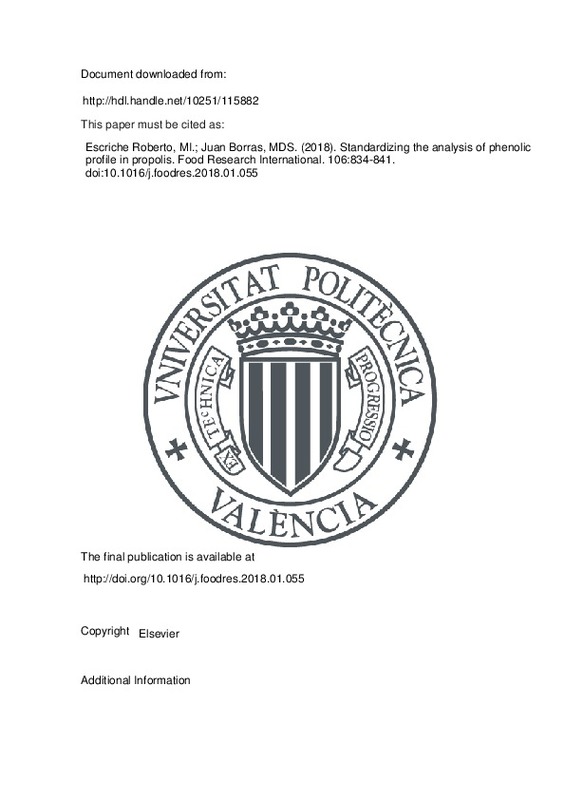JavaScript is disabled for your browser. Some features of this site may not work without it.
Buscar en RiuNet
Listar
Mi cuenta
Estadísticas
Ayuda RiuNet
Admin. UPV
Standardizing the analysis of phenolic profile in propolis
Mostrar el registro sencillo del ítem
Ficheros en el ítem
| dc.contributor.author | Escriche Roberto, Mª Isabel
|
es_ES |
| dc.contributor.author | Juan Borras, María del Sol
|
es_ES |
| dc.date.accessioned | 2019-01-20T21:05:06Z | |
| dc.date.available | 2019-01-20T21:05:06Z | |
| dc.date.issued | 2018 | es_ES |
| dc.identifier.issn | 0963-9969 | es_ES |
| dc.identifier.uri | http://hdl.handle.net/10251/115882 | |
| dc.description.abstract | [EN] The analysis of propolis is controversial, hampering the comparison of its biological properties and estimation of its commercial value. This work evaluates the effectiveness of combining maceration and ultrasonication extraction techniques on the yield, total phenol content (Folin-Ciocalteau) and the specific phenolic compounds (HPLC-UV), on propolis from different origins. The extraction method was not significant in any case; therefore ultrasonication is recommended (time-saving) but only when a double extraction is performed. Propolis yield varies significantly between samples, as it includes impurities, consequently the results should be expressed considering the yield (as balsam) instead of raw propolis. Of the 13 quantified phenolic compounds, CAPE and pinocembrin (803 and 701 mg/g balsam) stand out. The phenolic profile of a propolis must be fixed using both total phenol content (with a consensus reference compound) and the specific phenolic compounds, since the latter provides information about compounds that can play a significant antioxidant role. | es_ES |
| dc.description.sponsorship | The research was funded by the 2016 ADSIDEO-Cooperation Programa of the Centre for Development Cooperation of the Universitat Politecnica de Valencia (Spain). | |
| dc.language | Inglés | es_ES |
| dc.publisher | Elsevier | es_ES |
| dc.relation.ispartof | Food Research International | es_ES |
| dc.rights | Reconocimiento - No comercial - Sin obra derivada (by-nc-nd) | es_ES |
| dc.subject | Propolis | es_ES |
| dc.subject | Phenolics | es_ES |
| dc.subject | Folin-Ciocalteau | es_ES |
| dc.subject | Extraction methodology | es_ES |
| dc.subject.classification | TECNOLOGIA DE ALIMENTOS | es_ES |
| dc.title | Standardizing the analysis of phenolic profile in propolis | es_ES |
| dc.type | Artículo | es_ES |
| dc.identifier.doi | 10.1016/j.foodres.2018.01.055 | es_ES |
| dc.rights.accessRights | Abierto | es_ES |
| dc.date.embargoEndDate | 2019-04-01 | es_ES |
| dc.contributor.affiliation | Universitat Politècnica de València. Departamento de Tecnología de Alimentos - Departament de Tecnologia d'Aliments | es_ES |
| dc.contributor.affiliation | Universitat Politècnica de València. Instituto Universitario de Ingeniería de Alimentos para el Desarrollo - Institut Universitari d'Enginyeria d'Aliments per al Desenvolupament | es_ES |
| dc.description.bibliographicCitation | Escriche Roberto, MI.; Juan Borras, MDS. (2018). Standardizing the analysis of phenolic profile in propolis. Food Research International. 106:834-841. doi:10.1016/j.foodres.2018.01.055 | es_ES |
| dc.description.accrualMethod | S | es_ES |
| dc.relation.publisherversion | http://doi.org/10.1016/j.foodres.2018.01.055 | es_ES |
| dc.description.upvformatpinicio | 834 | es_ES |
| dc.description.upvformatpfin | 841 | es_ES |
| dc.type.version | info:eu-repo/semantics/publishedVersion | es_ES |
| dc.description.volume | 106 | es_ES |
| dc.relation.pasarela | S\359456 | es_ES |
| dc.contributor.funder | Universitat Politècnica de València |







![[Cerrado]](/themes/UPV/images/candado.png)

